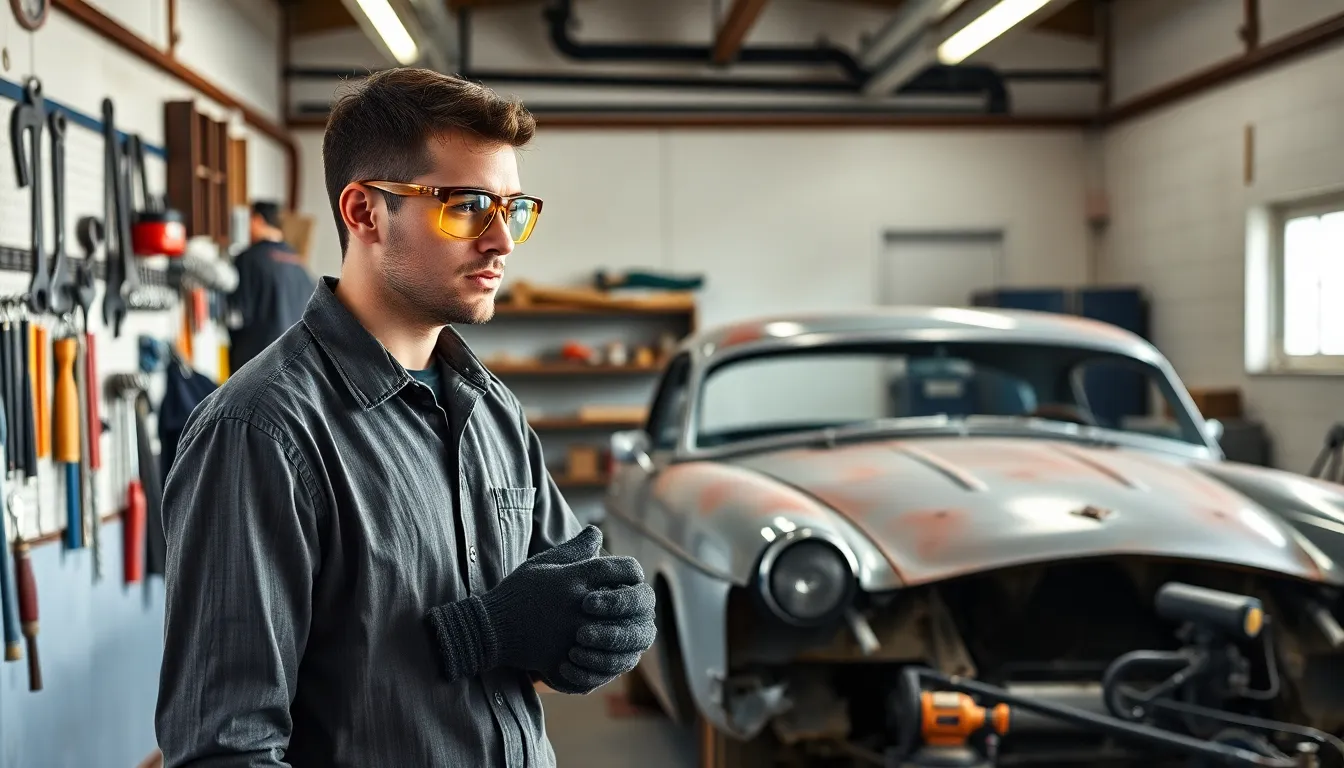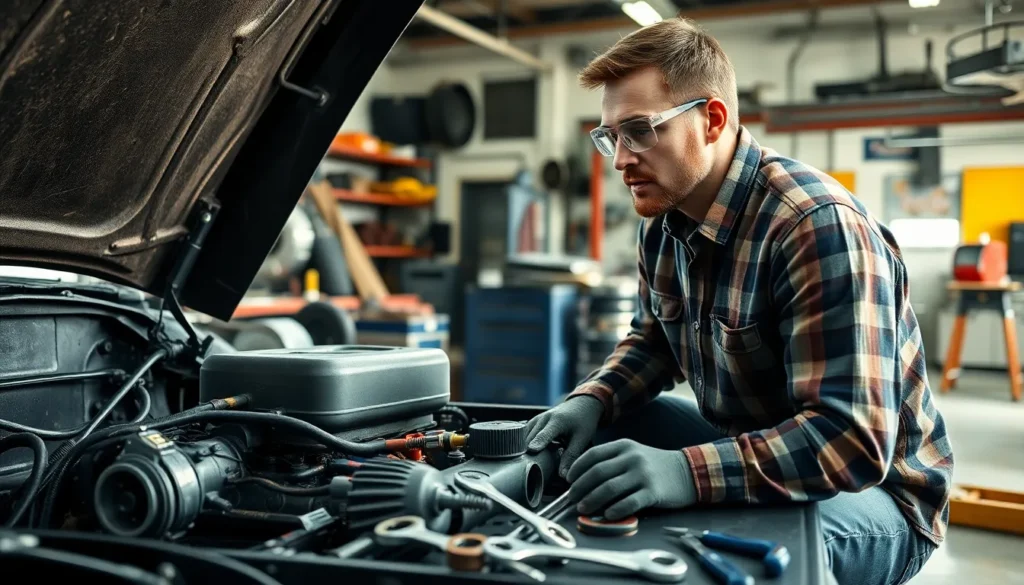Table of Contents
ToggleRestoring a car isn’t just a hobby; it’s a thrilling adventure that can turn rust buckets into gleaming masterpieces. Imagine the satisfaction of breathing new life into a classic ride, all while dodging the occasional grease stain and that stubborn bolt that just won’t budge. Whether it’s a vintage Mustang or a forgotten hatchback, every restoration project offers a chance to unleash creativity and craftsmanship.
Steps To Restore A Car
Restoring a car involves several essential steps, ensuring a structured approach to the project. Following a clear plan leads to a successful transformation.
Assessing The Condition Of The Car
Evaluating the car’s condition starts with a thorough inspection. Check the bodywork for rust, dents, or damage, as these issues dictate the repair scope. Examine the engine for functionality and leaks. Inspect the interior for wear and tear, along with the condition of seats and trim. Take note of the tires and suspension components. Document each finding to establish priorities and gain a clear idea of the restoration’s extent.
Creating A Restoration Plan
Creating a restoration plan involves outlining specific goals and timelines. Set a budget to cover parts, tools, and unforeseen expenses. Identify key tasks such as bodywork, mechanical repairs, and interior restoration. Schedule timelines for each phase, allowing flexibility for unexpected challenges. Research necessary parts and sources, including aftermarket options or original components. Finalize a timeline incorporating all tasks, catering to personal availability and project scope.
Necessary Tools And Equipment

Restoring a car requires a specific set of tools and equipment to ensure a successful transformation. Having the right resources simplifies the restoration process, making the journey more efficient and enjoyable.
Common Tools Used In Car Restoration
Wrenches play a crucial role in loosening and tightening bolts, ensuring secure connections. Screwdrivers come in various sizes and types, aiding in the assembly and disassembly of different parts. Pliers serve multiple purposes, such as gripping and twisting wires or small components. Additionally, a socket set accommodates different fastener types while providing better torque. Furthermore, sanders and grinders assist in bodywork preparation by smoothing surfaces and removing rust. Finally, safety gear, including gloves and goggles, protects while utilizing these tools.
Safety Equipment To Consider
Safety goggles protect the eyes from debris and chemicals during restoration tasks. Ear protection safeguards against loud noises from tools like grinders or compressors. Gloves offer hand protection while handling sharp parts and hazardous substances. A dust mask or respirator prevents inhalation of harmful particles during sanding or painting. Steel-toed boots provide foot safety against heavy objects that might fall during the restoration process. Lastly, a fire extinguisher should be readily available for emergencies involving flammable materials.
Disassembly Process
Disassembling a car requires careful attention to detail. Each step plays a crucial role in ensuring a smooth restoration process.
Documenting Every Step
Maintaining thorough documentation during disassembly aids in reassembly. Take photos from multiple angles of each component before removal. Jot down notes about any parts that may require specific attention during reinstallation. Documenting tools and techniques used for different parts streamlines the process. Use a binder or digital folder to organize photos and notes for easy access later. By keeping comprehensive records, they enhance the efficiency of reassembling the vehicle.
Organizing Parts For Reassembly
Organizing disassembled parts significantly simplifies the reassembly phase. Use labeled containers or bags for small components like screws and bolts. Arrange larger parts in a designated area to avoid confusion. Clearly label each container with the corresponding component name and its location on the vehicle. It’s beneficial to group similar parts together to minimize searching time. An organized workspace promotes a smooth transition from disassembly back to assembly, ensuring every piece finds its rightful place.
Restoration Techniques
Restoring a car involves several key techniques that transform an old vehicle into a stunning masterpiece. Understanding these methods enhances the overall restoration experience.
Bodywork And Painting
Bodywork repair involves fixing dents, rust, and structural issues. Inspecting the vehicle’s exterior helps identify problem areas. Once identified, sanding down rust patches prepares surfaces for treatment. Applying filler smooths imperfections before priming. Choosing high-quality paint ensures a durable finish that stands out. Finally, professional-grade clear coat provides added protection against elements. This process not only revives aesthetics but also strengthens the vehicle’s structure.
Mechanical Repairs And Upgrades
Mechanical repairs focus on restoring and enhancing engine performance. Starting with an engine inspection reveals potential issues, such as leaks or worn components. Replacing faulty parts, such as belts, hoses, and filters, significantly improves reliability. Upgrading components like exhaust systems and air intakes can enhance power and efficiency. Regular maintenance checks ensure longevity and optimal function. A focus on both repairs and upgrades creates a vehicle that performs as great as it looks.
Final Assembly And Detailing
Final assembly and detailing are crucial steps in the car restoration process. These stages ensure the vehicle looks and operates at its best.
Tips For A Professional Finish
Use quality products for polishing and waxing to achieve a brilliant shine. Choose a microfiber cloth, as it minimizes scratches and swirl marks during the detailing process. Inspect all seams and gaps; unevenness can indicate missed adjustments during assembly. Apply detailer’s clay to remove embedded contaminants from the paint surface before polishing. Additionally, utilize high-quality sealants for long-lasting protection against environmental elements. Ensure all components fit securely; rattling or misalignment can detract from the overall finish. Clean all glass surfaces thoroughly for a crystal-clear view. Use tire dressing to enhance the tires’ appearance, adding a finishing touch to the restoration. Focus on these details to transform the car into a stunning, polished masterpiece.
Restoring a car is an enriching journey that combines creativity with technical skills. From assessing the vehicle’s condition to the final detailing touches each step plays a vital role in achieving a stunning transformation.
With the right tools and a well-structured plan restorers can navigate challenges and enjoy the process. The satisfaction derived from breathing new life into a forgotten vehicle is unmatched.
Ultimately the dedication and effort invested in restoration not only enhance the car’s aesthetics and performance but also create a personal connection that lasts for years to come.







